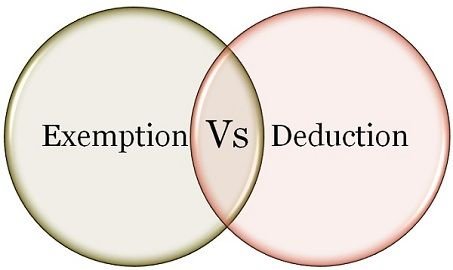Tax Exemption vs. Deduction: How to Lower Your Taxes
Greetings,
we filed our income tax this time, we faced many difficulties. These problems must be common for many people. So, I decided to write a post about tax exemptions and deductions, which will be helpful. I researched this topic on Google and also took advice from my husband to write this.

ImageSource
What is a Tax Deduction?
A tax deduction means you can subtract certain expenses or investments from your total income. These deductions are available under various sections of the Income-tax Act, 1961. By using these deductions, you can decrease your taxable income, leading to a lower tax bill. Here are some key deductions:
Key Sections and Limits
Section 80C: Investments/expenses up to ₹1.5 lakh.
Section 80CCD (1b): Contributions to NPS up to ₹50,000.
Section 80D: Medical insurance premium up to ₹25,000 (below 60 years) and ₹50,000 (above 60 years).
Section 80E: Interest paid on an education loan for 8 years.
Section 80G: Donations with a 50% or 100% deduction.
Section 80TTA: Interest on savings account up to ₹10,000 (below 60 years).
Section 80TTB: Interest up to ₹50,000 (60 years and above).
Example Calculation
Gross Total Income: ₹20 lakh
Deductions:
Section 80C: ₹1.5 lakh
Section 80D: ₹20,000
Section 80CCD (1b): ₹35,000
Total Deductions: ₹2.05 lakh
Taxable Income: ₹17.95 lakh (Gross Total Income - Total Deductions)
This calculation shows how you can use different deductions to lower your taxable income, resulting in tax savings.
What is a Tax Exemption?
A tax exemption means that certain types of income are not subject to tax, instead of taxing your entire income. For example, agricultural income or allowances provided by an employer such as House Rent Allowance (HRA) or Leave Travel Allowance (LTA) can be tax-exempt.
Key Sections and Limits
Tax exemptions are provided under Section 10 of the Income-tax Act, 1961, most of which have been removed under the new tax regime. Here are a few:
Section 10(13) (HRA): The least of the following:
Actual HRA received from the employer
50% of (basic salary + DA) for metro cities; 40% for non-metro cities
Actual rent paid minus 10% of (basic salary + DA)
Section 10(5) (LTA) : Decided by the employer. Twice in a block of four years.
Section 10(14) (Meal) : ₹50 per meal
Example
In the example mentioned above, if your taxable income is ₹17.95 lakh and you have claimed ₹1.5 lakh HRA exemption and ₹1 lakh LTA exemption as per your employer's allowance, your taxable income will be reduced.
Taxable Income : ₹17.95 lakh
Exemptions : HRA ₹1.5 lakh + LTA ₹1 lakh = ₹2.5 lakh
New Taxable Income : ₹15.45 lakh
Thus, tax exemptions are an efficient way to reduce your tax liability. You can save a significant part of your income and use it for other essential expenses.
Both tax exemptions and tax deductions are crucial tools for lowering your taxes. By understanding and applying them correctly, you can reduce your taxable income and reach your financial goals faster. We hope this blog enhances your understanding and helps you with your tax planning. If you have faced similar issues while filing your taxes, I hope this post provides some clarity and assistance.
Source
Very nice